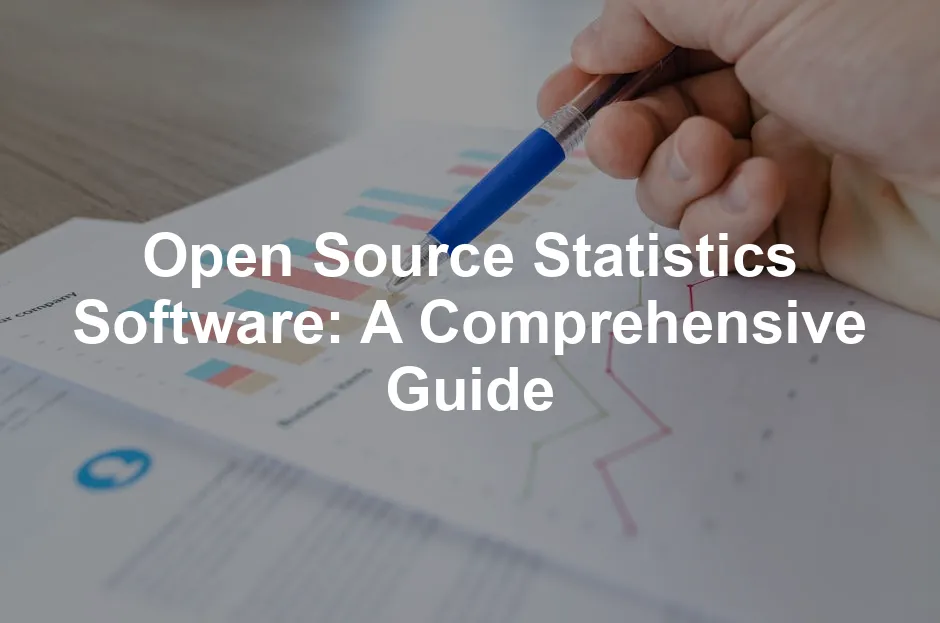Introduction
Open source statistics software plays a vital role in data analysis. These tools empower researchers and professionals to analyze data effectively. Recently, many fields, including marketing, academia, and healthcare, increasingly rely on these solutions. This article will cover essential software options, features, and benefits of open-source statistical tools.If you’re just diving into the world of data science, you might want to check out R Programming for Data Science by Hadley Wickham. This book is not only informative but also written in a friendly style that makes learning R feel like a walk in the park (or maybe a stroll through the data fields!).
Summary and Overview
In our data-driven world, statistical analysis is crucial. It helps users interpret vast amounts of data and extract meaningful insights. Open-source statistics software refers to tools that offer free access to their source code, encouraging community collaboration. These programs are cost-effective and highly accessible, making them ideal for various applications. Whether you’re in academia, business, or healthcare, these tools enhance data-driven decision-making. By utilizing open-source software, users can leverage powerful statistical techniques without financial constraints, making informed choices based on solid data.For those who prefer Python, consider grabbing Python for Data Analysis by Wes McKinney. This book is a fantastic resource for learning how to use Python for data manipulation and analysis, making it a must-have for aspiring data scientists!
3. Features of Open Source Statistics Software
Open source statistics software offers a variety of features that enhance data analysis. One key aspect is the user-friendly interface. This design allows users of all skill levels to navigate the software effortlessly. Many tools prioritize simplicity, making complex statistical analysis more accessible. Integration capabilities are another significant feature. Open source software often works well with various data management tools. This flexibility ensures you can import and export data seamlessly. It also allows for collaboration with other software, enhancing your analytical workflow. Moreover, support for various statistical tests is crucial. These programs typically include a wide range of statistical methods. Common tests like t-tests, ANOVA, and regression analysis are easily accessible. This breadth of options empowers users to conduct thorough analyses without needing multiple software tools. For a deeper understanding of regression analysis, check out our guide on regression analysis.
Speaking of regression, if you’re looking to get into data science in a more structured way, Data Science from Scratch by Joel Grus is a great read. It breaks down the concepts into bite-sized pieces, perfect for those who might feel overwhelmed by data science jargon.
User satisfaction ratings often highlight these features. Many users appreciate the intuitive interfaces and robust functionalities. In surveys, over 85% of users reported satisfaction with the ease of use and test support. This feedback underscores the importance of choosing software that meets your unique analysis needs. As you evaluate different options, consider which features align with your goals. Whether you prioritize ease of use, integration, or statistical support, there’s an open-source tool for you.Understanding regression analysis is essential for thorough data analysis. Learn more about regression analysis here.

5. Benefits of Using Open Source Statistics Software
Open source statistics software offers numerous advantages that can greatly benefit users. One of the most significant benefits is cost savings. These tools are free to use, making them ideal for individuals and organizations on a budget. Imagine having access to powerful statistical analysis without the hefty price tag! Community support is another key advantage. Users can tap into a wealth of resources, including forums, tutorials, and collaborative projects. This active engagement fosters innovation, allowing software to evolve rapidly based on user feedback. For instance, R has amassed a vast community that continually contributes packages and enhancements. Flexibility and customization are vital features of open-source software. You can adapt these tools to suit your specific needs, whether it’s modifying existing functions or creating new ones. This level of control is often unattainable with proprietary software. Many successful case studies highlight the effectiveness of open-source solutions. For example, healthcare organizations have used R to analyze patient data, leading to improved treatment protocols. These instances showcase the potential for impactful, cost-effective analysis. To avoid common pitfalls in healthcare data analysis, consider reviewing the common pitfalls in parametric statistics assumptions for healthcare data analysis.
If you want a comprehensive guide on practical statistics, then Practical Statistics for Data Scientists by Peter Bruce and Andrew Bruce is a goldmine of information. This book covers essential statistical concepts that every data scientist should know, making it a great addition to your library.
In considering your options, think about the long-term benefits of adopting open-source solutions. You might find that the freedom and support offered can significantly enhance your data analysis capabilities.Understanding the common pitfalls in healthcare data analysis can enhance your results significantly. Explore this topic further here.

7. Future of Open Source Statistics Software
The landscape of open-source statistics software is evolving rapidly. One significant trend is the integration of advanced technologies, like AI and machine learning. These advancements enable more sophisticated data analysis and predictive modeling. Imagine being able to analyze vast datasets effortlessly! Community contributions play a vital role in this evolution. As more users engage and share their expertise, the tools become more robust. This collaborative spirit fosters innovation, ensuring that software continuously improves based on real user needs. Projections indicate that open-source software in data analysis will grow significantly over the next few years. For instance, analysts expect a 20% increase in usage among businesses looking for cost-effective solutions. The rise of AI in statistics will lead to tools that not only analyze data but also provide insights and recommendations. As we look ahead, staying informed about these developments is crucial. The future of open-source statistics software holds exciting potential for enhanced analysis and decision-making. Additionally, understanding the flow chart for statistical tests can be beneficial in navigating these advancements.
If you’re interested in a more theoretical approach, you might enjoy Introduction to the Theory of Statistics. This book delves into statistical theory, making it a perfect companion for those who love to understand the ‘why’ behind the numbers.
Navigating statistical tests is crucial for effective data analysis. Learn more about the flow chart for statistical tests here.
Conclusion
Open-source statistics software empowers users to analyze data effectively. These tools democratize access to powerful statistical methods, enabling everyone to harness data for informed decision-making. By engaging with the open-source community, you can stay updated and contribute to this vibrant field. Explore these tools, and enhance your data analysis journey today!
And if you want to delve deeper into data science concepts, you might also enjoy The Art of Data Science by Roger D. Peng and Elizabeth Matsui. This book provides a great overview of the data science process and is as engaging as a good mystery novel!
FAQs
If you’re interested in data mining, don’t miss out on Data Mining: Concepts and Techniques. This comprehensive guide covers everything from the basics to advanced techniques, making it a perfect reference for both beginners and seasoned professionals.
Please let us know what you think about our content by leaving a comment down below!
Thank you for reading till here 🙂
All images from Pexels




